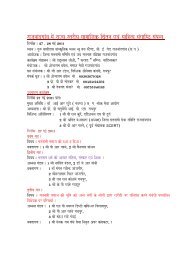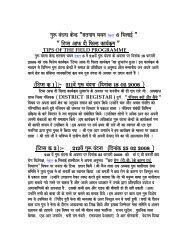Revolution and Counter-Revolution in Ancient India - Satnami.com
Revolution and Counter-Revolution in Ancient India - Satnami.com
Revolution and Counter-Revolution in Ancient India - Satnami.com
You also want an ePaper? Increase the reach of your titles
YUMPU automatically turns print PDFs into web optimized ePapers that Google loves.
calledDevas who were Aryans but of a superior status <strong>and</strong> prowess. The Aryans<br />
allowed their women to have sexual <strong>in</strong>tercourse with any one of the class of<br />
Devas <strong>in</strong> the<strong>in</strong>erest of good breed<strong>in</strong>g. This practice prevailed so extensively that<br />
the Devas came to regard prelibation <strong>in</strong> respect of the Aryan women as their<br />
prescriptive right. No Aryan woman could be married unless this right of<br />
prelibation had been redeemed <strong>and</strong> the woman released from the control of the<br />
Devas by offer<strong>in</strong>g what was technically called Avadan. The Laja Hoame which is<br />
performed <strong>in</strong> every H<strong>in</strong>du marriage <strong>and</strong> the details of which are given <strong>in</strong><br />
the Ashwalayan Grahya Sutra is a relic of this act of the redemption of the Aryan<br />
woman from the right of prelibation of the Devas. The Avadan <strong>in</strong> the Laja Hoame<br />
is noth<strong>in</strong>g but the price for theext<strong>in</strong>guishment of the right of the Devas over the<br />
bride. The Saptapadi performed <strong>in</strong> all H<strong>in</strong>du marriages <strong>and</strong> which is regarded as<br />
the most essential ceremony without which there is no lawful marriage has an<br />
<strong>in</strong>tegral connection with this right of prelibation of the Devas. Saptapadi means<br />
walk<strong>in</strong>g by the bridegroom seven steps with the bride. Why is this essential? The<br />
answer is that the Devas if they were dissatisfied with the <strong>com</strong>pensation could<br />
claim the woman before the seventh step was taken. After the seventh step was<br />
taken, the right of the Devas was ext<strong>in</strong>guished <strong>and</strong> the bridegroom could take<br />
away the bride <strong>and</strong> live as husb<strong>and</strong> <strong>and</strong> wife without be<strong>in</strong>g obstructed or<br />
molested by the Devas.<br />
There was no rule of chastity for maidens. A girl could have sexual <strong>in</strong>tercourse<br />
with <strong>and</strong> also progeny from anybody without contract<strong>in</strong>g marriage. This is<br />
evident from the root mean<strong>in</strong>g of the word Kanya which means a<br />
girl. Kanya <strong>com</strong>es from the root Kam which means a girl free to offer herself to<br />
any man. That they did offer themselves to any man <strong>and</strong> had children without<br />
contract<strong>in</strong>g regular marriage is illustrated by the case<br />
of Kunti <strong>and</strong> Matsyag<strong>and</strong>ha. Kunti had children from different men before she<br />
was married to P<strong>and</strong>u <strong>and</strong> Matsyag<strong>and</strong>ha had sexual <strong>in</strong>tercourse with the<br />
sage Parashara before she was married to Shantanu the father ofBhishma.<br />
Bestiality was also prevalent among the Aryans. The story of the sage Dam<br />
hav<strong>in</strong>g sexual <strong>in</strong>tercourse with a female deer [f32] is well known. Another <strong>in</strong>stance<br />
is that of Surya cohabit<strong>in</strong>g with a mare [f33] .. But the most hideous <strong>in</strong>stance is that<br />
of the woman hav<strong>in</strong>g sexual <strong>in</strong>tercourse with the horse <strong>in</strong><br />
the Ashvamedha Yadna.<br />
The religion of the Aryan consisted of the Yadna or sacrifice. The sacrifice was<br />
a means to enter <strong>in</strong>to the godhead of the gods, <strong>and</strong> even to control the gods.<br />
The traditional sacrifices were twenty-one <strong>in</strong> number divided <strong>in</strong>to three classes<br />
of seven each. The first were sacrifices of butter, milk, corn, etc. The second<br />
class covered Soma sacrifices <strong>and</strong> third animal sacrifices. The sacrifice may be<br />
of short duration or long duration last<strong>in</strong>g for a year or more. The latter was called





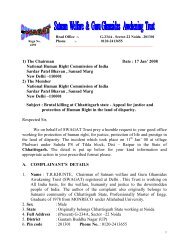
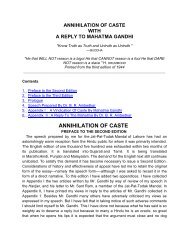


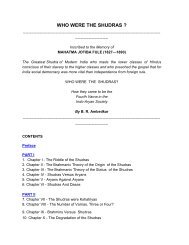

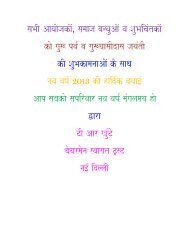
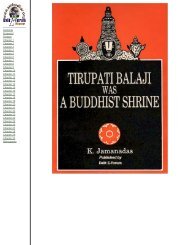
![saaQa satnaamaI saaQa satnaamaI ]%tr Baart ka mah%vapUNa ...](https://img.yumpu.com/5897453/1/190x245/saaqa-satnaamai-saaqa-satnaamai-tr-baart-ka-mahvapuna-.jpg?quality=85)
